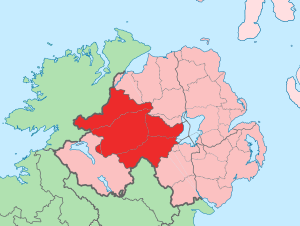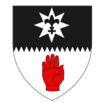County Tyrone facts for kids
Quick facts for kids
County Tyrone
|
||
|---|---|---|
|
||
| Nickname(s):
The Red Hand County
|
||
| Motto(s): | ||
 |
||
| Country | United Kingdom | |
| Region | Northern Ireland | |
| Province | Ulster | |
| Established | 1585 | |
| County town | Omagh | |
| Area | ||
| • Total | 1,261 sq mi (3,270 km2) | |
| Area rank | 8th | |
| Highest elevation | 2,224 ft (678 m) | |
| Population
(2021)
|
188,383 | |
| • Rank | 11th | |
| Time zone | UTC±0 (GMT) | |
| • Summer (DST) | UTC+1 (BST) | |
| Postcode area | ||
| Contae Thír Eoghain is the Irish name; Countie Tyrone, Coontie Tyrone and Coontie Owenslann are Ulster Scots spellings (the latter used only by Dungannon & South Tyrone Borough Council). | ||
County Tyrone is one of the six counties in Northern Ireland. It's also one of the nine counties in the larger region of Ulster and one of the thirty-two traditional counties of Ireland. The main town in County Tyrone is Omagh.
This county is located near the southwest shore of Lough Neagh, which is a very large lake. County Tyrone covers an area of about 3,266 square kilometers (1,261 square miles). This makes it the biggest county in Northern Ireland by size. It's also the second largest county in Ulster, after Donegal. In 2021, about 188,383 people lived here, making it the 5th most populated county in Northern Ireland and Ulster. The county gets its name from an old Gaelic kingdom called Tír Eoghain, which was around until the 1600s.
Contents
What is County Tyrone?
County Tyrone is a historic area in Northern Ireland. It's known for its beautiful landscapes and rich history. The county is a mix of flat lands and mountains.
Where Does the Name Come From?
The name Tyrone comes from the Irish words Tír Eoghain. This means "land of Eoghan". Eoghan was an important leader from a long time ago. The name was given to the lands that the Cenél nEógain group took over. In the past, people sometimes spelled it Tirowen or Tyrowen. These spellings were closer to how it sounded in Irish.
A Look at Tyrone's Past
For many years, Tyrone was much bigger than it is today. It stretched north all the way to Lough Foyle. It even included parts of what is now County Londonderry. The land east of the River Foyle was part of Tyrone.
How Tyrone Changed Over Time
Between 1610 and 1620, most of County Londonderry was separated from Tyrone. This land was given to groups from London. They wanted to make money from the natural resources there. Tyrone was the main home of the O'Neill families. They were the strongest Gaelic Irish families in Ulster for a long time. The old area of Tír Eoghain, which belonged to the O'Neills, included all of today's Tyrone and Londonderry counties. It also included four areas in County Donegal.
In 1608, during O'Doherty's Rebellion, some parts of the county were attacked and burned. This happened when Sir Cahir O'Doherty destroyed Derry. However, O'Doherty's men did not touch the lands of Earl of Tyrone. They were afraid of him if he returned from his travels.
Exploring Tyrone's Geography
County Tyrone is the largest county in Northern Ireland. It covers about 3,266 square kilometers (1,261 square miles). The eastern part of Tyrone has flat, marshy lands. These lands are next to Lough Neagh, the biggest lake in the British Isles.
Mountains, Lakes, and Rivers
As you go west, the land slowly rises into mountains. This area is around the Sperrin Mountains. The highest point in Tyrone is Sawel Mountain. It stands tall at 678 meters (2,224 feet). The county stretches about 55 miles (88 km) from the River Blackwater at Lough Neagh to the west. It is about 37.5 miles (60 km) wide from south to northeast. A place called Annaghone is thought to be the exact center of Northern Ireland.
Tyrone shares its borders with several other counties. To the southwest, it's connected to County Fermanagh. To the south, it borders County Monaghan. County Armagh is to the southeast. To the north, you'll find County Londonderry, and to the west is County Donegal. Across Lough Neagh to the east, it touches County Antrim. Tyrone is the eighth largest county in Ireland by area. It is the second largest of Ulster's nine traditional counties.
Who Lives in County Tyrone?
County Tyrone is one of four counties in Northern Ireland where most people are from a Catholic background. This was shown in the 2021 census. In 1900, Tyrone had about 197,719 people. By 2021, the population was 188,383.
People and Their Backgrounds
The 2021 census showed that about 66.5% of people were from a Catholic background. About 28.9% were from a Protestant or other Christian background. A small number, 0.7%, were from other religions. About 4.0% said they had no religious background.
People in Tyrone also have different national identities. The 2021 census showed that about 41.6% identified as Irish only. About 21.0% identified as British only. Another 20.5% identified as Northern Irish only. Some people identified with a mix of these.
Towns and Villages in Tyrone
County Tyrone has many towns and villages. Here are some of the main ones:
Large towns
(These towns have between 18,000 and 75,000 people)
Medium towns
(These towns have between 10,000 and 18,000 people)
Small towns
(These towns have between 4,500 and 10,000 people)
Intermediate settlements
(These towns have between 2,250 and 4,500 people)
Villages
(These villages have between 1,000 and 2,250 people)
- Ardboe
- Carrickmore
- Dromore
- Fintona
- Fivemiletown
- Killyclogher
- Moy
- Newtownstewart
- Sion Mills
Small villages
(These villages have less than 1,000 people)
- Altamuskin
- Altmore
- Ardstraw
- Artigarvan
- Augher
- Aughnacloy
- Ballygawley
- Ballymagorry
- Benburb
- Beragh
- Bready
- Brockagh
- Caledon
- Clady
- Clogher
- Clonoe
- Coagh
- Derryloughan
- Derrytresk
- Donaghmore
- Donemana
- Drumquin
- Edenderry
- Eglish
- Erganagh
- Eskra
- Evish
- Glenmornan
- Gortin
- Greencastle
- Killyclogher
- Loughmacrory
- Kildress
- Plumbridge
- Pomeroy
- Rock
- Stewartstown
- Tamnamore
- Trillick
- Tullyhogue
- Victoria Bridge
Sports and Fun in Tyrone
Sports are very popular in County Tyrone! The main sports include Gaelic games, association football (soccer), rugby union, and cricket.
Gaelic Games
Gaelic football is played more often than hurling in Tyrone. The Tyrone GAA football team has been very successful since 2000. They have won the All-Ireland title four times (in 2003, 2005, 2008, and 2021). They have also won sixteen Ulster titles and two National League titles.
Football (Soccer)
Soccer also has many fans in Tyrone. Omagh Town F.C. used to play in the top league but stopped in 2005. Dungannon Swifts F.C. currently plays in the NIFL Premiership, which is the top soccer league. Other teams include NIFL Championship side Dergview F.C..
Rugby Union
Rugby is very popular too. Teams like Dungannon RFC, Omagh Academicals RFC, and Clogher Valley RFC play in the All-Ireland League. Other teams are Cookstown RFC and Strabane RFC.
Cricket
International Cricket matches are played at the Bready Cricket Club Ground. This ground is owned by Bready Cricket Club. It's Ireland's fourth place for international cricket. It hosted its first international match in June 2015. It was also chosen to host games for the 2015 ICC World Twenty20 Qualifier tournament.
Famous Faces from Tyrone
Many interesting and famous people come from County Tyrone! Here are just a few:
- Philomena Begley, an Irish country music singer
- Paul Brady, a musician
- Conor Bradley, a footballer
- Peter Canavan, a former captain of the Tyrone Gaelic football team
- William Carleton (1794–1869), a well-known writer
- Darren Clarke, a professional golfer
- Tom Clarke, an Irish leader during the 1916 Easter Rising
- Jimmy Cricket, a comedian
- Austin Currie, a politician and founding member of the SDLP
- Janet Devlin, a singer who was on The X Factor
- Ryan Dolan, who represented Ireland in the Eurovision Song Contest 2013
- Brian Dooher, a former captain of the Tyrone senior football team
- John Dunlap (1747–1812), who printed the first American daily newspaper and the Declaration of Independence
- Brian Friel, a famous writer and theatre director
- Aaron Hughes, a captain of the Northern Ireland football team
- Ryan Kelly, a singer with Celtic Thunder
- Benedict Kiely (1919–2007), a writer and broadcaster
- Conor McKenna, an AFL Player
- William McMaster (1811–1887), who started the Canadian Bank of Commerce and has a university named after him
- Thomas Mellon, who started Mellon Bank
- Sister Nivedita (1867–1911), an Irish social activist
- Flann O'Brien (1911–1966), a writer
- Hugh O'Neill, Earl of Tyrone (c.1550–1616), an important Irish leader
- Dennis Taylor, a former world snooker champion
See also
 In Spanish: Condado de Tyrone para niños
In Spanish: Condado de Tyrone para niños



